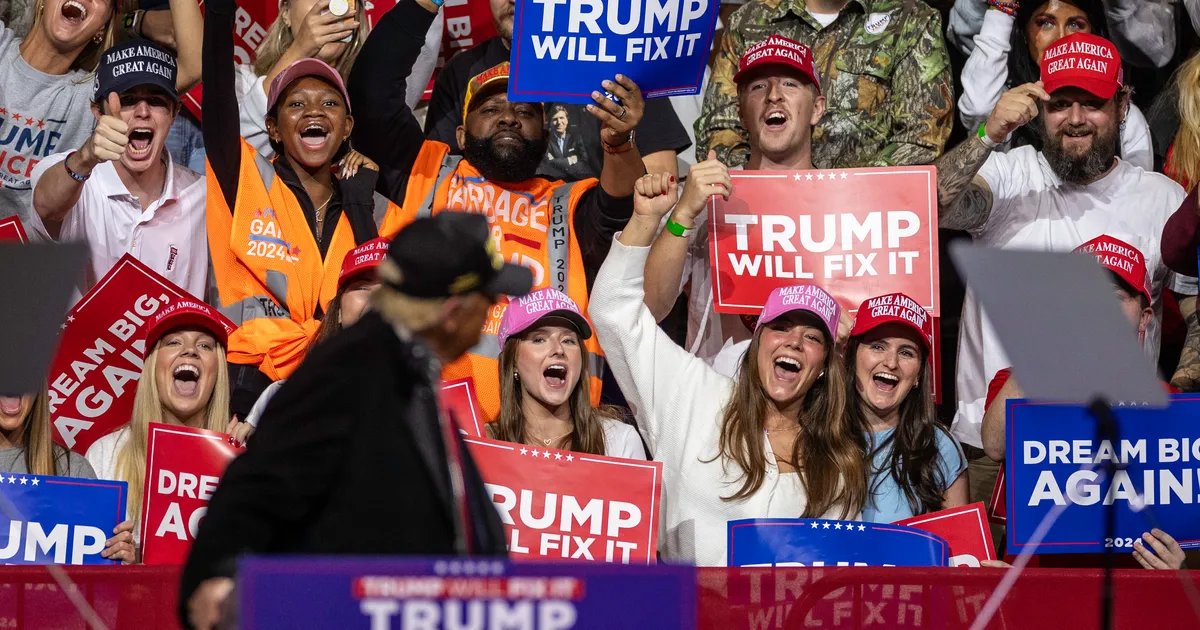
We tend to picture American politics in the Donald Trump era as two more-or-less equally matched coalitions of voters who have wildly disparate views of public policy and are very angry about it. The current federal-government shutdown, in which the two parties in Congress are shouting at each other on social media but not talking to each other at all, reflects this perspective of total gridlock. Thanks to our winner-take-all system of electoral rewards, however, Republicans control everything in Washington, D.C., despite narrow advantages in House and Senate membership and a close presidential win in 2024. It’s worth asking now whether they still have an advantage in the broader electorate given all the hype about a growing GOP coalition based on Trump inroads into young, Black, and Latino constituencies last year.
The expanding GOP coalition appears to be shrinking again, mostly because the promise of a great economy under Trump 2.0 is looking like an illusion if not a lie, as Politico explains:
President Donald Trump’s surprising performance among Black Americans and younger voters helped him win the popular vote in the 2024 election. Those constituencies are still waiting for a return on their investment.
The unemployment rate for Americans between the ages of 16 and 24 has jumped to 10.5 percent from 9 percent since Trump returned to the White House, a period that coincided with a marked decline in their participation in the labor force. Black joblessness has also climbed, with federal workforce cuts and a broad slowdown in hiring contributing to the rise. And both groups saw their paychecks drop through the first half of the year, despite an acceleration in weekly earnings for workers overall.
GOP gains among Latinos in 2024 were particularly momentous given that demographic’s rapid growth and strategic position within the traditional Democratic coalition. But it’s increasingly clear that Trump’s standing among Latinos is suffering from a combination of broken economic promises and a mass-deportation program that in breadth and violence far exceeds anything these voters expected. The withering of the Trump 2024 coalition is made especially clear in a major New York Times–Siena national poll of registered voters released this week.
The survey shows Trump’s overall job-approval rating pretty near where the polling averages have recently placed it: 43 percent approval, 54 percent disapproval. As has also been the case in virtually every recent survey, intensity levels are higher among Trump opponents: 29 percent of voters strongly approve of his job performance, and 46 percent strongly disapprove. That’s right: Nearly half of registered voters can’t stand the president.
When you move on to the demographic groups where Trump made his 2024 gains, though, you see some remarkable unhappiness. Among under-30 voters, Trump’s job-approval ratio is 29 percent positive and 66 percent negative, with 52 percent strongly disapproving (and only 13 percent strongly approving). Among Latinos, all but claimed as a permanent GOP voting segment by some Trump enthusiasts, his job-approval ratio is 26 percent positive and 69 percent negative, with 57 percent strongly disapproving. And among Black voters, so often thought to be trending red in and after 2024, Trump’s job-approval ratio is an exceptionally dismal 10 percent positive and 84 percent negative, with 72 percent strongly disapproving. There’s no way to spin these numbers as anything other than a rebuke to the 47th president. And there’s more: 52 percent of women from all backgrounds strongly disapprove of Trump’s job performance, as do 55 percent of white college graduates.
Where is the president’s base of support in this survey? It’s where it’s always been since 2016, among white non-college voters. These folks approve of Trump’s job performance by a 62 percent to 36 percent margin, with 44 percent strongly approving. Because they make up 39 percent of the poll’s sample, they do indeed place a floor under measurements of his popularity. But this doesn’t represent a growing coalition reaching into previously Democratic strongholds.
If you want to see a demographic category where the stereotype of roughly equal and intensely polarized coalitions rings true, look at seniors (over-65 voters) in the Times–Siena survey — 46 percent approve of Trump’s job performance, with 36 percent doing so strongly. Fifty percent disapprove, nearly all of them (46 percent) strongly. Only 14 percent of these boomers don’t feel strongly about Trump. And while midterm turnout rates of young, Black, and Latino voters can sometimes lag — particularly among the low-information voters who tilted to Trump in 2024 — seniors are notoriously prone to vote in all elections. All in all, the president’s base is loud but rather lonely at present, and Republican hopes of a national voter realignment in their favor are still just dreams.



